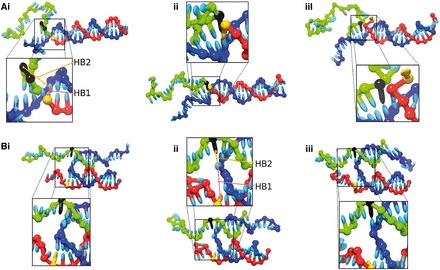Figure 12.

Typical branch migration steps as represented by oxDNA, for a toehold length of three bases. In each case, the nucleotide colored black displaces the nucleotide colored gold. (A) Displacement via invasion: a base from the invading strand enters the incumbent/substrate duplex and competes with a base from the incumbent for base pairing. (i) Initial state, with the gold-colored base on the incumbent bound to the substrate and the black-colored base on the invading strand unbound. (ii) Metastable intermediate with both the gold and black bases competing for base pairing with the substrate. (iii) Final state, with the black base bound to the substrate and the gold base unbound. (B) Displacement via sequential disruption and formation of bonds: a base pair in the incumbent/substrate duplex breaks and the substrate base unstacks and moves across to the invading/substrate duplex. (i) Coaxially unstacked initial state, with the gold-colored base on the incumbent bound to the substrate and the black-colored base on the invading strand unbound. (ii) Metastable intermediate state, in which the base pair involving the gold base has broken, and the base from the substrate strand has unstacked. (iii) Final state, with the substrate base now bound to the black base in the invading strand. Labeled distances between hydrogen-bonding sites are used as coordinates to monitor branch migration steps in detail later in Figure 13.
